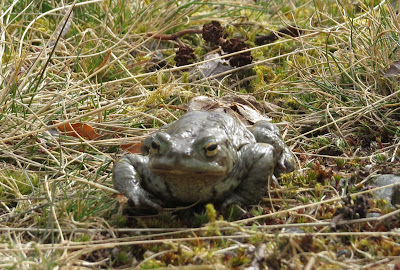| An atmospheric shot of a Cairngorms moorland at dawn |
To give you an idea of what you may realistically hope to see if you are planning a future May visit, I hope the following more detailed information, illustrated with photos taken by myself or my safari clients will help........
Local speciality and upland bird species seen regularly this month included:
Osprey, Black Grouse (pre-dawn start required), Red Grouse, Ring Ouzel, Slavonian Grebe, Red-Throated Diver, Black-Throated Diver, Goldeneye, Dipper, and rather surprisingly, Scottish Crossbill, with just a couple of views of Golden Eagle and Merlin, and one of a Short-Eared Owl .....it should be noted though, that we failed to see the very secretive Capercaillie and Crested Tit at all this month...
Mammals seen regularly by my safari parties during the month included:
Rabbit, Mountain Hare (now a mottled grey-white), Brown Hare, Roe Deer, Red Deer, Reindeer, Red Squirrel, Mountain Goat and Bank Vole, with just a few brief glimpses of both Stoat and Weasel...
| Osprey with trout by safari client Gary Wills |
| Black Grouse lekking at dawn |
| Cock Red Grouse |
| Ring Ouzel |
| Slavonian (Horned) Grebe |
The extremely beautiful (and incredibly rare) Slavonian Grebes were again seen and enjoyed regularly on suitably quiet local lochs, with the male birds seen fishing and delivering food to the nests hidden in the bankside sedge beds.....
| Black-Throated Diver |
Both Red-Throated and Black-Throated Divers too, UK-wise, are only really found breeding, and in their dapper summer plumage, on suitable lochs in northern Scotland. Due to their general shyness, most views we get are through a scope at a fair distance, and any ripple on the water makes finding them very difficult, but on a couple of occasions we get lucky and obtained a slightly closer look..
| Drake Goldeneye |
The same could be said of our Goldeneye, with them too being a north of Scotland speciality, and late in the month we got to see their ridiculously cute youngsters too... nice!
| Newly-fledged Dipper |
Dippers are always popular with my safari clients, and from mid-month we saw the parent birds flying back to their nest with beaks full of insects (see pic above) and later on we got to see the very cute newly fledged youngsters out on the rivers with their parents for the first time this year....
| Male Scottish Crossbill |
Scottish Crossbills are usually the cause of much frustration on my safaris, with me regularly hearing their distinctive 'jip' jip' jip' calls overhead, and my safari clients getting just a brief glimpse of the birds flying away, never to be seen again! But this month, they were actually very obliging, with us getting some great views, on a number of occasions, even through the scope, of family parties feeding together on pine cone seeds, giving us the chance to admire the brick-red males, greeny-yellow females and streaky youngsters - excellent stuff!
Golden Eagle is another iconic Scottish bird which always seems to be on visiting birders 'wish-lists', and we are fortunate to have a number of suitable upland glens nearby, however, with 18+ hours of daylight in which to hunt, the chances of just happening to be in the right place at the right time to see one are fairly low during the summer months, we did however manage to get a few decent views, particularly earlier in the month...
Merlin is another raptor which you need a bit of luck (or lots of time!) to get to see hunting over it's moorland home, on the 13th however, we got to see one chasing a Meadow Pipit and then perching on a rock briefly...then flying away as I raised my camera....
| Wood Warbler |
Other good birds of note seen this month included:
Several pairs of Wood Warblers singing well in a local birch wood, and at the same venue, a female Pied Flycatcher, seemingly prospecting a nest-box....Bullfinches early in the day at forest feeding stations ,Cuckoo, Redstart, Golden Plover, and plenty of Spotted Flycatchers catching insects in our local forests....
| Male Bullfinch by safari client Gary Wills |
Although I didn't make any trips up to the mountain-tops this month in search of Ptarmigan and Snow Bunting, a few of my safari clients did, with a few decent sightings of both species being achieved....
May is definitely 'fledgling month', and we saw youngsters of many species, including Osprey, Scottish Crossbill, Red Grouse, Dipper, Lapwing, Curlew, Goldeneye, Mallard and Greylag Goose...
Our local Mountain Hares, though they are now in their blue-grey Spring outfits, again proved popular with my safari clients, and were seen to be chasing each other around in a frisky fashion....Being animals of remote upland habitat, they are not easily seen by most UK wildlife-watchers... and were often voted 'mammal of the day'....
| Young Mountain Goats |
| Red Squirrel by safari client Gary Wills |
| Super Red Deer stag action pic by safari client Deborah Hutchinson |
It's always nice to see Deer too, and early starts and a variety of habitats on the itinerary can give us the best chance of seeing up to four different species, though it is the local speciality Red Deer and Reindeer that are usually the most popular....
| Caledonian pine forest |
So to summarise, May was another excellent month for wildlife watching in this area, and is probably THE month to visit if you are wanting to see a good cross-section and maximum numbers of both Highland and more common bird and mammal species in a large variety of very different habitats, in (usually) good weather conditions, and still with nice snowy backdrops. I certainly enjoyed looking through my reports and photos whilst compiling this update, and I hope you enjoyed reading it too....









